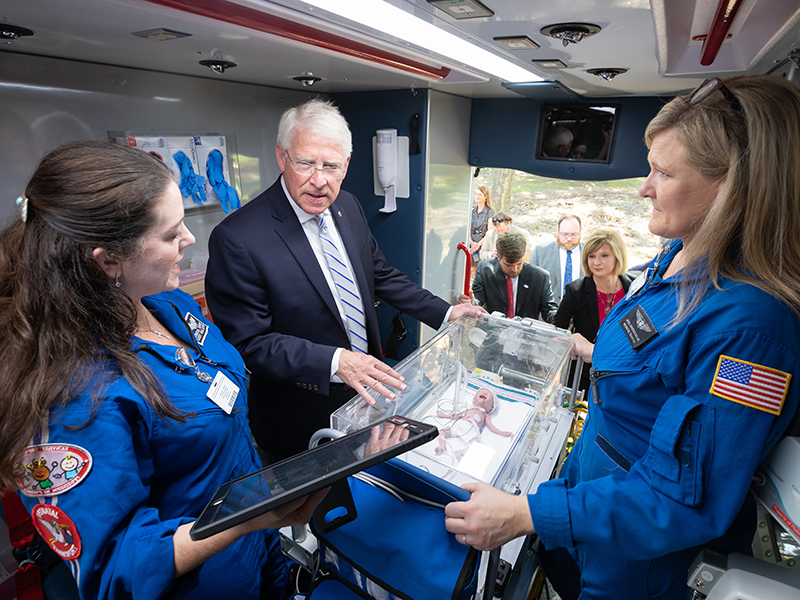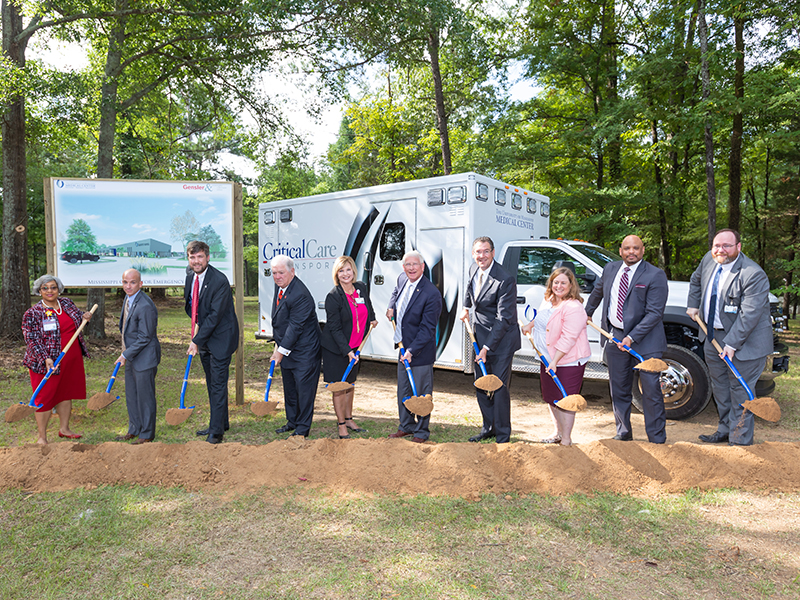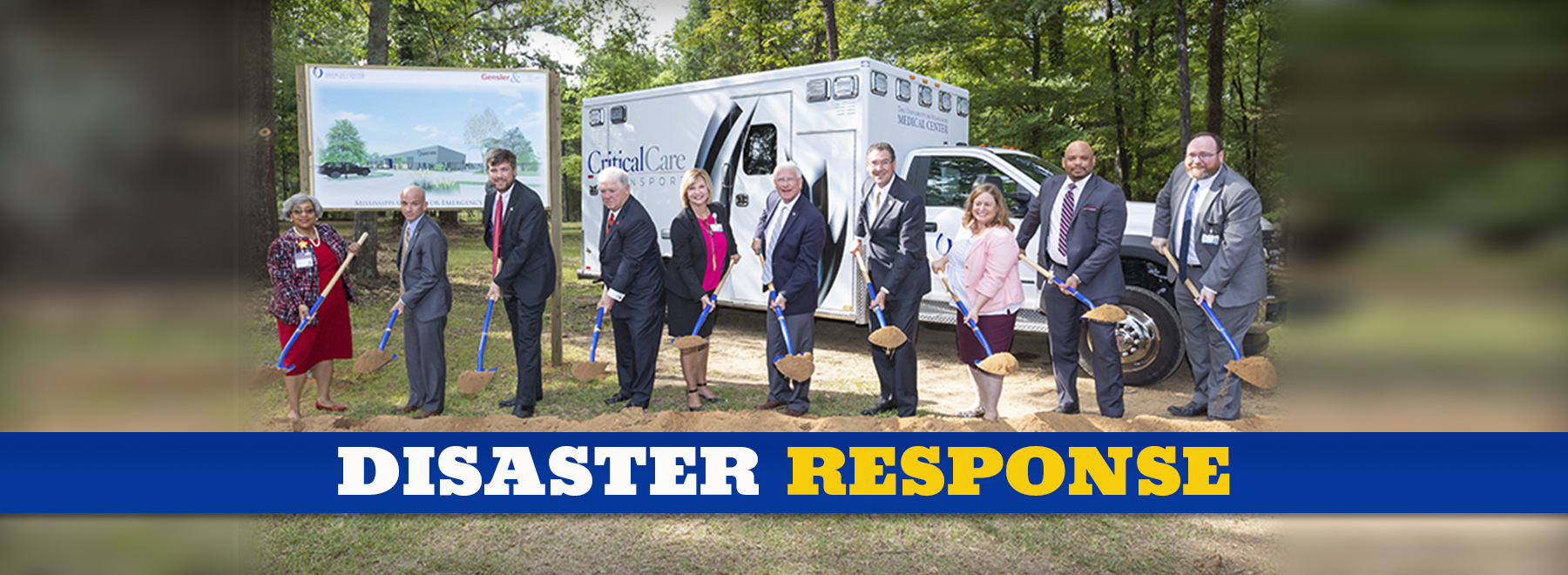Groundbreaking signals coordinated emergency response facility at UMMC
Published on Monday, September 10, 2018
By: Ruth Cummins
Dr. Damon Darsey and Dr. Jonathan Wilson had a dream — really, more a resolve to make a dream come true — after Hurricane Katrina slammed the Gulf Coast in 2005.
In the hours and days following the storm that killed more than 230 in Mississippi and wreaked staggering devastation, the state’s emergency responders had no idea of the challenges they would face to deliver medical care, and no idea how challenging it would be to do something we all take for granted: talk to each other.

Darsey, then a paramedic with the University of Mississippi Medical Center’s AirCare medical helicopter transport, and Wilson, then a UMMC Adult Emergency Department nurse, vowed to seek solutions so that next time, Mississippi would be ready.
“We began to dream about the possibilities of what could be emergency communications,” Darsey said.
Lessons learned from that record disaster galvanized efforts by Wilson, Darsey and the state emergency response community to create Mississippi’s first comprehensive emergency medical response system. That network includes the Mississippi Center for Emergency Services, or MCES. The center was established in 2014 by UMMC to expand Mississippi’s ability to maintain medical communications for disasters and emergency preparedness and response.
The dream was realized Aug. 9 when ground was broken for MCES’ first permanent home that will combine all of its services under one roof.
“Right now, we are spread out across campus, and our campus is the size of a small city,” said Darsey, associate professor of emergency medicine and MCES medical director. “This will get us all back in the same area to improve efficiency and workflow, and to better manage our projects.
“This is a dream come true for many of us. We’ve been talking about this for many years, and now we’re physically able to do it.”
The state-of-the-art facility, with space for the federally funded Mississippi Integrated Public Safety Communications Center, will allow better coordination between the state’s emergency response agencies and quicker deployment of medical care to sites of disasters or emergencies.

U.S. Sen. Roger Wicker and former U.S. Sen. Thad Cochran led the effort to shepherd almost $20 million in federal grant funding in jeopardy of being canceled to build a home for the MCES and outfit it with the latest technology. Construction is set to begin this fall and is estimated to take 18 months.
“This is a game-changer,” Wicker said during the groundbreaking ceremony on the northeast corner of UMMC’s campus, near where the center will be built. “This is a quantum leap for Mississippi. We’re going to save lives by bringing to fruition what we are here for today.”
Partners in the grant awarded by the U.S. Department of Commerce’s National Technical Information Service are the office of Gov. Phil Bryant, the Mississippi Wireless Information Network (MSWIN for short) and the Mississippi Department of Information Technology Services.
“Public safety has always been my number one priority, and this new facility for MCES will give our first responders better coordination and quicker response times to disasters,” Bryant said in a statement.
The single-story, 20,000-square-foot building will house Mississippi MED-COM, the 24-hour communications center that coordinates patient care and transport with emergency response agencies, hospitals and first responders statewide. MED-COM now operates out of cramped quarters near UMMC’s Adult ED.

The facility will be a user-friendly base of operations for projects that will advance the state’s medical response and emergency critical care capabilities. It will include a 10,000-square-foot training and simulation area for emergency responders.
Among the scenarios: replicating limitations to broadband connections in the state’s rural corners so first responders can brainstorm how to communicate around it. And it will bring together emergency transport teams, their vast deployable gear and administrative support under one roof.
In coordination with emergency response agencies and partners statewide, “we stand ready for the next disaster, if it occurs,” Dr. LouAnn Woodward, UMMC vice chancellor for health affairs, said during the event. “We’re in a very different place now than we were (when Katrina hit) on Aug. 29, 2005.
“When you see all of our partners here, we know that great things can happen at UMMC.”
Under former Gov. Haley Barbour’s leadership, in 2010 the state of Mississippi won a $73 million Broadband Technology Opportunity Program federal award to develop a state-of-the-art public safety communications and pre-hospital medical communications system. That grant was put on hold in 2014 to avoid duplicating a federal program deploying similar technology.
Instead, in 2016 Mississippi was approved to move forward with a modified version of the grant. That modification allowed for the expansion of the MSWIN, development of a Mobile Tele-Assist System and construction of the Mississippi Integrated Public Safety Communications Center at UMMC.

The MSWIN expansion includes enhanced data-carrying capabilities and the opportunity for research and development on the use, training and policy development of mobile telemedicine.
Darsey said in a disaster, “people don’t always understand the power of talking to each other. Many people don’t understand the power of a black box, but it is instrumental to everything we do.”
Wilson, UMMC’s chief administrative officer, and Dr. Alan Jones, professor and chair of emergency medicine, are MCES’ administrative leaders. Wilson was among eight UMMC staffers deployed in the wake of Katrina to assess damages at Hancock County Medical Center.
Their mission quickly changed to one of medical response as they gave desperately needed help to hospital staff, treating the wounded and preparing patients for transport.
“We’ve taken those lessons and applied them to construction of this building,” Wilson said. “Everything is designed to support all of the needs of the medical community and emergency services.
“This building gives us the ability to advance that learning process to improve patient care, not just during a disaster, but every day.”
The facility will provide a second campus helipad for UMMC’s AirCare, the state’s most advanced medical helicopter transport. AirCare will still land on the roof of UMMC’s critical care hospital to deliver patients for treatment, but will be staffed and deployed from the MCES.
“We can pull the helicopters inside the building for use in our simulation training,” Darsey said. “The new space will protect our assets from inclement weather.”

UMMC can cross-train first responders by bringing to MCES aircraft from partnering emergency response agencies, such as the Mississippi National Guard or the state Department of Public Safety. That could include U.S. Army Lakota helicopters and National Guard Blackhawk rescue helicopters.
“We want what we do to be aligned with what they do,” Wilson said.
The facility reflects the threefold mission of the Medical Center, Wilson said.
“It has a component around education and training, a section that’s about clinical care in disasters and everyday emergencies, and the infrastructure to do research,” he said. “This building is another example of the recipe for success that we see here at the Medical Center.
“We take highly trained and educated personnel and give them access to advanced technology and equipment, and that really benefits patient care. We can apply that same recipe to future technology and training.”
Darsey posed a question at the groundbreaking: “Where do we go from here?”
“This building will allow us to really stretch the envelope,” he said. “Now we have a platform to jump from.”



